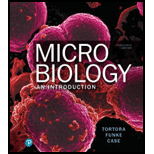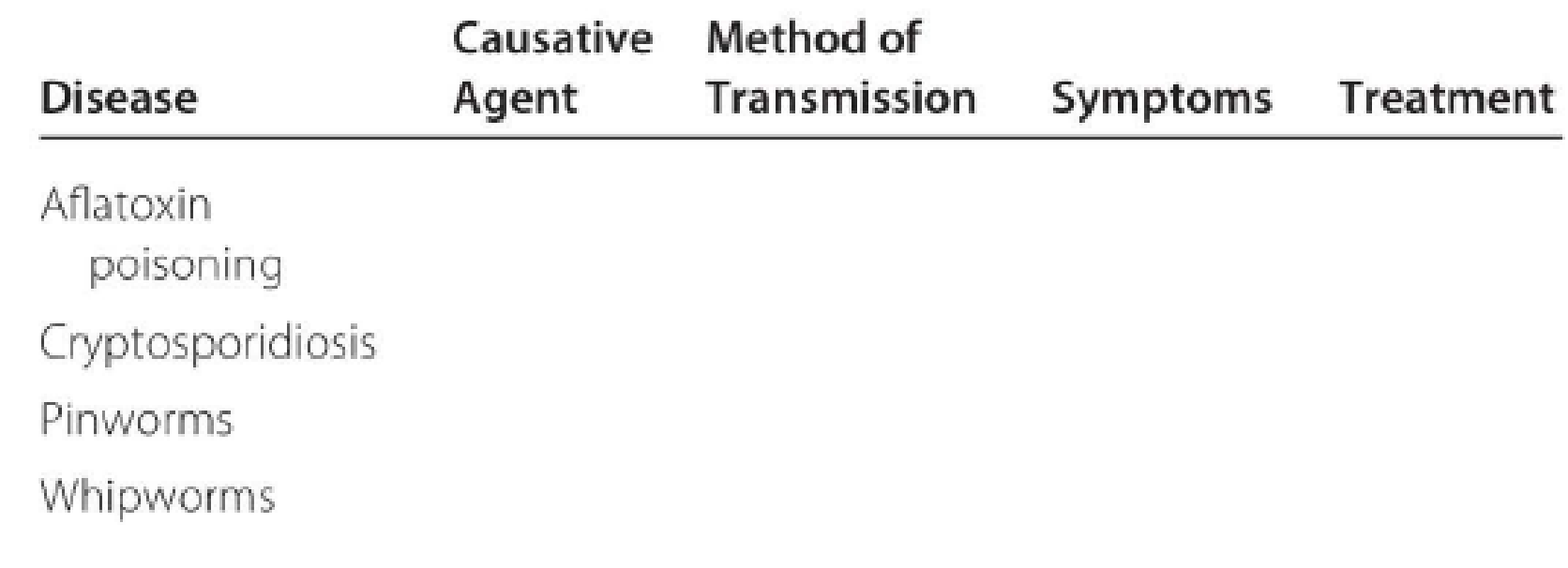
Concept explainers
Complete the following table:

To review:
The causative agent, method of transmission, symptoms, and treatment of pathogenic diseases, such as aflatoxin poisoning, cryptosporidiosis, pinworms, and whipworms.
Introduction:
Microorganisms that have the ability to cause infectious diseases are called as pathogens. Such microorganisms include bacteria, fungi, virus, and protozoa. Illness in an individual is caused either by disturbing the normal metabolic activity of the host or by inducing the host’s immune system to produce a response. Infectious agents are transmitted by direct contact (person-to-person) or indirect contact (water-borne, food-borne, air-borne, soil-borne, fomite-borne, vector-borne, and zoonosis). Infectious diseases are responsible for the high frequency of human morbidity and mortality world-wide.
Explanation of Solution
| Disease | Causative Agent | Method of Transmission | Symptoms | Treatment |
| Aflatoxin poisoning | Aspergillus flavus | Food-borne: ingestion of toxin (peanuts, cereals, dried fruit) | Acute necrosis of liver, liver cirrhosis, liver cancer, abdominal pain, nausea, vomiting | None |
| Cryptosporidiosis | Cryptosporidium parvum, Cryptosporidium hominis | Water-borne: ingestion of oocysts | nausea, fever, abdominal pain watery diarrhea, prolonged diarrhea (immunosuppressed patients) | Oral rehydration, antiparasitic drug (Nitazoxanide) |
| Pinworms | Enterobius vermicularis | Fecal-oral route: ingestion of pinworm eggs, fomite-borne: bedding, clothing | Local itching (anus) | Antihelminthic drugs (pyrantel pamoate, mebendazole) |
| Whipworms | Trichuris trichiura | Soil-borne: ingestion of eggs | Diarrhea, abdominal pain | Antihelminthic drugs (mebendazole, albendazole) |
The causative agent, method of transmission, symptoms, and treatment of pathogenic diseases, such as aflatoxin poisoning, cryptosporidiosis, pinworms, and whipworms is tabulated.
Want to see more full solutions like this?
Chapter 25 Solutions
Microbiology: An Introduction Plus Mastering Microbiology with Pearson eText -- Access Card Package (13th Edition) (What's New in Microbiology)
Additional Science Textbook Solutions
Organic Chemistry
Chemistry & Chemical Reactivity
Fundamentals Of Thermodynamics
Genetics: From Genes to Genomes
Campbell Essential Biology (7th Edition)
- Noggin mutation: The mouse, one of the phenotypic consequences of Noggin mutationis mispatterning of the spinal cord, in the posterior region of the mouse embryo, suchthat in the hindlimb region the more ventral fates are lost, and the dorsal Pax3 domain isexpanded. (this experiment is not in the lectures).a. Hypothesis for why: What would be your hypothesis for why the ventral fatesare lost and dorsal fates expanded? Include in your answer the words notochord,BMP, SHH and either (or both of) surface ectoderm or lateral plate mesodermarrow_forwardNot part of a graded assignment, from a past midtermarrow_forwardNot part of a graded assignment, from a past midtermarrow_forward
- please helparrow_forwardWhat does the heavy dark line along collecting duct tell us about water reabsorption in this individual at this time? What does the heavy dark line along collecting duct tell us about ADH secretion in this individual at this time?arrow_forwardBiology grade 10 study guidearrow_forward
 Principles Of Radiographic Imaging: An Art And A ...Health & NutritionISBN:9781337711067Author:Richard R. Carlton, Arlene M. Adler, Vesna BalacPublisher:Cengage Learning
Principles Of Radiographic Imaging: An Art And A ...Health & NutritionISBN:9781337711067Author:Richard R. Carlton, Arlene M. Adler, Vesna BalacPublisher:Cengage Learning Biology Today and Tomorrow without Physiology (Mi...BiologyISBN:9781305117396Author:Cecie Starr, Christine Evers, Lisa StarrPublisher:Cengage Learning
Biology Today and Tomorrow without Physiology (Mi...BiologyISBN:9781305117396Author:Cecie Starr, Christine Evers, Lisa StarrPublisher:Cengage Learning Human Biology (MindTap Course List)BiologyISBN:9781305112100Author:Cecie Starr, Beverly McMillanPublisher:Cengage Learning
Human Biology (MindTap Course List)BiologyISBN:9781305112100Author:Cecie Starr, Beverly McMillanPublisher:Cengage Learning





